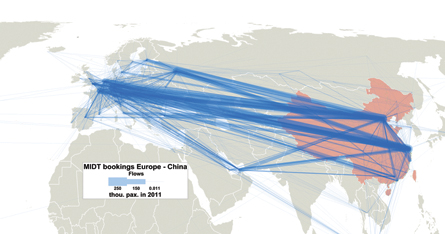The Middle East giants have turned their hubs into important conduits for the passenger flow between Europe and China
The rapid growth in European connections and frequencies by the Middle East's three global network carriers - Emirates, Qatar Airways and Etihad Airways - raises the question as to how effective their strategy has been in attracting traffic on key routes such as between Europe and China.
Even with optimised Middle East hub waves the additional routing can add six to seven hours - about 1,600nm (3,000km) - compared with a direct flight from London to Shanghai.
It can add four hours compared with routing through a European hub connection. The effectiveness of competition for traffic can be gauged from the results of a recent market study by Flightglobal Ascend, looking at the trends on the China-Europe corridor.
The market in 2011 shows about 44% of travel was direct, and around 51% made with one connection. If we focus on the top European or Middle Eastern hubs for this one connection between Europe and mainland China in 2011, Emirates' Dubai hub was nearly three times bigger than London Heathrow as a transfer point. In fact, Heathrow is only just ahead of Qatar's Doha base as a hub for this type of traffic.
Flows for one-hub connections between Europe and China: 2011 |
|---|
 |
The three Middle East hubs account for more than 8% of passenger traffic that made a connection in Europe or the Middle East, and about 5% of all traffic between Europe and China.
The developing strength of the model adopted by the three Gulf carriers is emphasised by a look at the number of European points served from their hubs - 36 airports in February 2012, served with a total of nearly 100 services a day. This contrasts with the 16 European airports from which European or Chinese carriers fly direct to/from China.
One of the incentives offered by these airlines, of particular interest for premium business traffic, is a discounted fare. From the analysis for 2011, the saving on a premium business-class fare seemed to average 20-25% against a direct routing. With round-trip fares in the region of $5,500, this has become an interesting corporate reason for route selection in troubled times.
The European/Chinese airlines flying direct offer a slightly more diverse range of Chinese destinations, and greater frequency to those destinations than the three Gulf carriers. They also have the major benefit of non-stop services for direct flyers.
It will be interesting to see how China's increasing interests in Africa, Middle East and South America will influence their capacity into China. This can effectively repeat their multi-destination success on a European connection strategy, with a proliferation of Chinese markets.
Peter Morris is chief economist at Flightglobal's data and consultancy arm Ascend
Doha is just behind Heathrow in terms of China transfer traffic
Source: Airline Business























